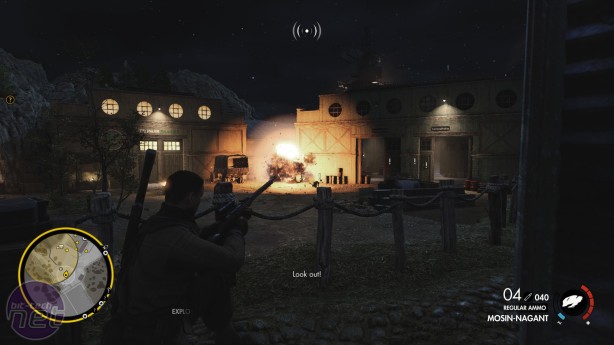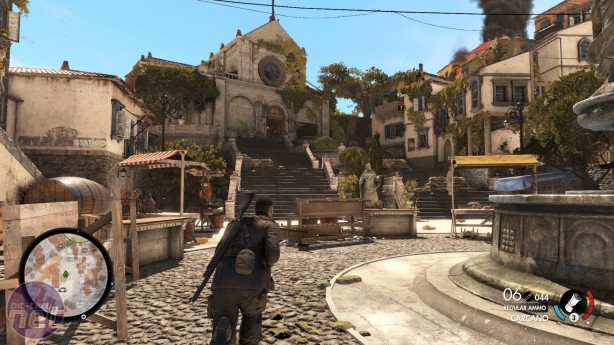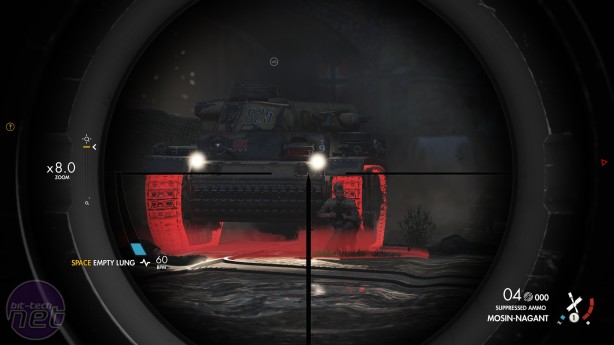
To do this, though, you do have to adjust your mindset to suit the game. At first I was quite frustrated with Sniper Elite 4 because I was trying to play it like a traditional stealth game. Sniper Elite 4 certainly allows you to be sneaky and even improves the stealth mechanics by introducing more efficient melee kills and a limited supply of “suppressed” ammunition for your sniper rifle. But trying to remain undetected severely limits what you can do in the game. There is a certain satisfaction to scouring the levels for the perfect sniping position, where there’s a wide field of view and you can mask your shots by sabotaging a nearby generator, but it also severely limits your options, and makes you feel as if the game is pushing you through a certain path, despite its open nature.
Instead, the real fun of Sniper Elite 4 lies not in figuring out where the game wants you to be, but puppeteering your enemies so they move where you want them to be. To this end, Sniper Elite 4 greatly expands Fairburne’s equipment by giving all his items and gadgets an alternate function. A basic example is that Fairburne can throw rocks to attract an enemy’s attention to a location, but he can also now whistle to bring an enemy to him. Meanwhile “Teller” mines can be configured to trigger when one or two enemies step on them, while grenades can be made adhesive so they stick to surfaces and enemies. So a standard tactic is to use a teller mine to set up a booby-trap on a body, and then whistle to attract nearby enemies to that location.
In addition to this, Rebellion has expanded the number of environmental objects you can use to your advantage. Explosives are liberally spread throughout all levels. Ammunition boxes, fuel barrels and even the fuel tanks of vehicles can be used to kill a group of enemies in a single shot, while cranes holding up nets filled with heavy objects can be destroyed with a well-placed bullet, raining death upon anyone who happens to be standing underneath it. Some of these useful objects are unique to specific levels. The aforementioned railway gun can be used to mask the sound of your shots whenever it fires, for example.
A further improvement Sniper Elite 4 makes is to the behaviour of your opponents. When alerted to your presence, German and Italian forces will immediately dive into cover. If they hear your shot, they’ll search the area where you fired from, and if they spot you will immediately open fire and signal for reinforcements. Some enemies can even call artillery strikes on your location, flushing you out from your hiding hole and forcing you to rethink your approach. At the same time, you can turn your enemies’ more robust behaviours to your advantage. Wound a soldier and another might rush out of cover to their aid, enabling you to take them out as well. Moreover, you can use their attempts to track down your position to set up a nasty surprise.
When you use all the tools at your disposal, Sniper Elite 4 is a thoroughly entertaining sandbox game. That said, it’s still some way behind the best games in its genre, like Hitman and Metal Gear Solid V. To begin with, the game lacks much sense of progression. As I mentioned earlier, the story is entirely frivolous. Some effort has been made to make it a touch more substantial, like pre-mission areas where you can talk to a few characters and receive objectives from them, but to be honest I found these to be obstructive rather than constructive. A bigger problem is that while you may face tougher opponents like tanks in later levels, the game never encourages you to adjust your tactics or try out new weapons. Sniper rifles in particular seem to have little that distinguishes one from another.
Where Sniper Elite does hold an advantage over these games is in its multiplayer component. As well as competitive sniping, Sniper Elite 4 also includes a substantial cooperative offering. The entire campaign can be played through cooperatively, and there’s also a rather slapdash survival mode. But this is more than made up for by Overwatch. Here, one player assumes the role of a sniper, while the other is a spotter/commando type, equipped with binoculars and a submachine-gun, but not a sniper rifle. The spotter is tasked with infiltrating a Nazi outpost, while the sniper must protect the commando from on-high, taking out the targets marked by the commando.
This asymmetrical approach works fantastically. Playing as the sniper feels immensely powerful, but the responsibility is on your shoulders to keep the spotter alive. You have to stay vigilant to the spotter’s calls, while also seeking out ideal sniping spots and avoiding hilltop patrols. The spotter’s role, meanwhile, is incredibly intense. Targeting an enemy and watching them crumple to the ground is incredibly satisfying. But you also feel extremely vulnerable, especially when the sniper is relocating or can’t get a good line of sight, leaving you temporarily on your own. Incidentally, it’s worth noting that Overwatch’s maps are designed specifically for the mode and are as large and complex as anything in the campaign.
Sniper Elite 4 may not make any bold leaps forward like the previous game did, but it does have a much clearer idea of what kind of game it wants to be, although it doesn’t always communicate that effectively to the player. Nevertheless, if you’re willing to get creative and not simply rely on your scope, you’ll discover that Sniper Elite is far more than just a game that lets you shoot Nazis in the testicles.
Instead, the real fun of Sniper Elite 4 lies not in figuring out where the game wants you to be, but puppeteering your enemies so they move where you want them to be. To this end, Sniper Elite 4 greatly expands Fairburne’s equipment by giving all his items and gadgets an alternate function. A basic example is that Fairburne can throw rocks to attract an enemy’s attention to a location, but he can also now whistle to bring an enemy to him. Meanwhile “Teller” mines can be configured to trigger when one or two enemies step on them, while grenades can be made adhesive so they stick to surfaces and enemies. So a standard tactic is to use a teller mine to set up a booby-trap on a body, and then whistle to attract nearby enemies to that location.
In addition to this, Rebellion has expanded the number of environmental objects you can use to your advantage. Explosives are liberally spread throughout all levels. Ammunition boxes, fuel barrels and even the fuel tanks of vehicles can be used to kill a group of enemies in a single shot, while cranes holding up nets filled with heavy objects can be destroyed with a well-placed bullet, raining death upon anyone who happens to be standing underneath it. Some of these useful objects are unique to specific levels. The aforementioned railway gun can be used to mask the sound of your shots whenever it fires, for example.
A further improvement Sniper Elite 4 makes is to the behaviour of your opponents. When alerted to your presence, German and Italian forces will immediately dive into cover. If they hear your shot, they’ll search the area where you fired from, and if they spot you will immediately open fire and signal for reinforcements. Some enemies can even call artillery strikes on your location, flushing you out from your hiding hole and forcing you to rethink your approach. At the same time, you can turn your enemies’ more robust behaviours to your advantage. Wound a soldier and another might rush out of cover to their aid, enabling you to take them out as well. Moreover, you can use their attempts to track down your position to set up a nasty surprise.
When you use all the tools at your disposal, Sniper Elite 4 is a thoroughly entertaining sandbox game. That said, it’s still some way behind the best games in its genre, like Hitman and Metal Gear Solid V. To begin with, the game lacks much sense of progression. As I mentioned earlier, the story is entirely frivolous. Some effort has been made to make it a touch more substantial, like pre-mission areas where you can talk to a few characters and receive objectives from them, but to be honest I found these to be obstructive rather than constructive. A bigger problem is that while you may face tougher opponents like tanks in later levels, the game never encourages you to adjust your tactics or try out new weapons. Sniper rifles in particular seem to have little that distinguishes one from another.
Where Sniper Elite does hold an advantage over these games is in its multiplayer component. As well as competitive sniping, Sniper Elite 4 also includes a substantial cooperative offering. The entire campaign can be played through cooperatively, and there’s also a rather slapdash survival mode. But this is more than made up for by Overwatch. Here, one player assumes the role of a sniper, while the other is a spotter/commando type, equipped with binoculars and a submachine-gun, but not a sniper rifle. The spotter is tasked with infiltrating a Nazi outpost, while the sniper must protect the commando from on-high, taking out the targets marked by the commando.
This asymmetrical approach works fantastically. Playing as the sniper feels immensely powerful, but the responsibility is on your shoulders to keep the spotter alive. You have to stay vigilant to the spotter’s calls, while also seeking out ideal sniping spots and avoiding hilltop patrols. The spotter’s role, meanwhile, is incredibly intense. Targeting an enemy and watching them crumple to the ground is incredibly satisfying. But you also feel extremely vulnerable, especially when the sniper is relocating or can’t get a good line of sight, leaving you temporarily on your own. Incidentally, it’s worth noting that Overwatch’s maps are designed specifically for the mode and are as large and complex as anything in the campaign.
Sniper Elite 4 may not make any bold leaps forward like the previous game did, but it does have a much clearer idea of what kind of game it wants to be, although it doesn’t always communicate that effectively to the player. Nevertheless, if you’re willing to get creative and not simply rely on your scope, you’ll discover that Sniper Elite is far more than just a game that lets you shoot Nazis in the testicles.


MSI MPG Velox 100R Chassis Review
October 14 2021 | 15:04














Want to comment? Please log in.